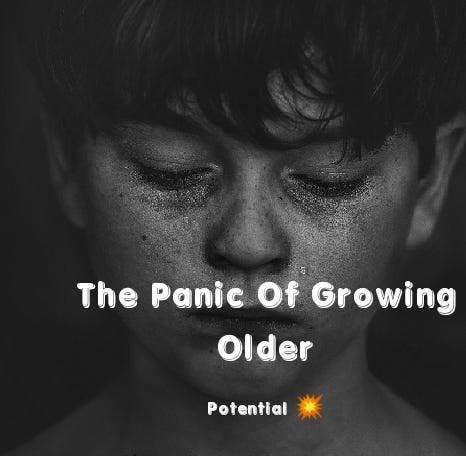Lenrie Peters’ “The Panic of Growing Older” is a reflective poem that delves into the universal human experience of aging. This profound work captures the feelings of uncertainty, regret, and realization that come with the passage of time. Through its poignant imagery and relatable themes, the poem speaks to the inevitability of growing older, while urging readers to reflect on how they live their lives.
This article explores the key themes, literary devices, and messages of the poem, making it accessible to readers who may not be familiar with Lenrie Peters or his body of work.
Summary of “The Panic of Growing Older”
The poem examines the various stages of life, highlighting the struggles, fears, and realizations that accompany aging. It portrays life as a journey filled with aspirations, achievements, and disappointments. Peters reflects on how youthful optimism often fades into the panic of unfulfilled dreams and the pressures of time. The poem’s tone oscillates between somber and contemplative, capturing the universal truth of human mortality and the fleeting nature of life.
Themes in “The Panic of Growing Older”
- The Passage of Time:
Peters emphasizes the relentless march of time, showing how quickly life progresses. - Regret and Reflection:
The poem explores the disappointment of unfulfilled dreams and missed opportunities. - Mortality and Aging:
The inevitability of aging and its associated fears are central to the poem’s narrative. - Life’s Expectations vs. Reality:
The poet contrasts the high hopes of youth with the realities of adulthood, showcasing the gap between dreams and achievements.
Literary Devices in “The Panic of Growing Older”
- Imagery:
Vivid descriptions help readers visualize the emotional and physical changes of aging. - Metaphor:
Aging is metaphorically described as a “panic,” highlighting its emotional impact. - Symbolism:
Life’s milestones, such as youth and middle age, are symbolic of broader human experiences. - Tone:
The reflective and somber tone emphasizes the poet’s deep contemplation of life. - Repetition:
The repetition of certain ideas underscores the inevitability and universality of aging.
Analysis of “The Panic of Growing Older”
Peters captures the universal fear of aging by examining the emotional, physical, and social implications of growing older. The poem reflects on how time erodes the vitality of youth, replacing it with a sobering awareness of life’s transience. Through his masterful use of language, Peters communicates the urgency of living a purposeful life while acknowledging the inevitability of decline.
The poem’s introspective nature resonates deeply with readers of all ages, offering a powerful reminder to cherish the present and pursue meaningful goals.
Why “The Panic of Growing Older” Matters
This poem remains relevant because it speaks to timeless human concerns. It encourages self-reflection and challenges readers to evaluate how they navigate the stages of life. Peters’ work serves as a poignant reminder of the importance of making the most of each moment.
Objective Questions and Answers on “The Panic of Growing Older”
- Who is the author of “The Panic of Growing Older”?
a) Gabriel Okara
b) Lenrie Peters
c) Wole Soyinka
d) Chinua Achebe
Answer: b) Lenrie Peters - What is the central theme of the poem?
a) The joy of aging
b) The inevitability of aging and time’s passage
c) The complexity of relationships
d) The beauty of nature
Answer: b) The inevitability of aging and time’s passage - What tone is used in the poem?
a) Joyful
b) Reflective and somber
c) Humorous
d) Indifferent
Answer: b) Reflective and somber - What does the poet mean by the “panic” in the title?
a) Fear of failure
b) The anxiety associated with aging
c) The joy of new opportunities
d) Fear of success
Answer: b) The anxiety associated with aging - What literary device is most prominent in the poem?
a) Simile
b) Metaphor
c) Onomatopoeia
d) Alliteration
Answer: b) Metaphor - What does the poem encourage readers to reflect on?
a) Their achievements
b) The passage of time and purpose of life
c) The beauty of nature
d) Their relationships
Answer: b) The passage of time and purpose of life - How does the poet describe youth?
a) As a period of fulfillment
b) As a time of high hopes
c) As an age of disappointment
d) As a phase of regret
Answer: b) As a time of high hopes - What is the poem’s perspective on aging?
a) It is a joyful process
b) It brings fear and reflection
c) It is irrelevant
d) It solves life’s problems
Answer: b) It brings fear and reflection - What literary device does Peters use to emphasize the inevitability of aging?
a) Hyperbole
b) Repetition
c) Allusion
d) Personification
Answer: b) Repetition - What is the message of the poem?
a) To avoid aging
b) To embrace life with purpose
c) To live in denial
d) To focus on material wealth
Answer: b) To embrace life with purpose - What does the poet highlight about missed opportunities?
a) They are unavoidable
b) They cause regret in later years
c) They lead to success
d) They are insignificant
Answer: b) They cause regret in later years - What does the poem suggest about youth?
a) It is fleeting
b) It is permanent
c) It guarantees happiness
d) It has no impact on aging
Answer: a) It is fleeting - What does the passage of time symbolize in the poem?
a) Peace
b) Growth
c) Mortality
d) Joy
Answer: c) Mortality - What does the poet encourage people to do with their lives?
a) Waste time
b) Reflect and live meaningfully
c) Ignore aging
d) Focus on material wealth
Answer: b) Reflect and live meaningfully - What does the poem critique about human nature?
a) Complacency in the face of time
b) The pursuit of happiness
c) The rejection of old age
d) The appreciation of life
Answer: a) Complacency in the face of time - What is the primary emotion evoked by the poem?
a) Happiness
b) Nostalgia and reflection
c) Anger
d) Indifference
Answer: b) Nostalgia and reflection - What does the poet view as a consequence of unfulfilled dreams?
a) Regret
b) Peace
c) Fulfillment
d) Indifference
Answer: a) Regret - What does the poem suggest about life’s expectations?
a) They are always met
b) They often differ from reality
c) They are insignificant
d) They bring joy
Answer: b) They often differ from reality - What is the mood of the poem?
a) Lighthearted
b) Reflective
c) Chaotic
d) Angry
Answer: b) Reflective - What does the poem say about the inevitability of aging?
a) It can be avoided
b) It is universal and inescapable
c) It is joyful
d) It has no significance
Answer: b) It is universal and inescapable

